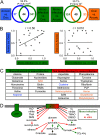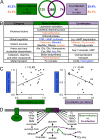A Commensal Bacterium Promotes Virulence of an Opportunistic Pathogen via Cross-Respiration
- PMID: 27353758
- PMCID: PMC4916382
- DOI: 10.1128/mBio.00782-16
A Commensal Bacterium Promotes Virulence of an Opportunistic Pathogen via Cross-Respiration
Abstract
Bacteria rarely inhabit infection sites alone, instead residing in diverse, multispecies communities. Despite this fact, bacterial pathogenesis studies primarily focus on monoculture infections, overlooking how community interactions influence the course of disease. In this study, we used global mutant fitness profiling (transposon sequencing [Tn-seq]) to determine the genetic requirements for the pathogenic bacterium Aggregatibacter actinomycetemcomitans to cause disease when coinfecting with the commensal bacterium Streptococcus gordonii Our results show that S. gordonii extensively alters A. actinomycetemcomitans requirements for virulence factors and biosynthetic pathways during infection. In addition, we discovered that the presence of S. gordonii enhances the bioavailability of oxygen during infection, allowing A. actinomycetemcomitans to shift from a primarily fermentative to a respiratory metabolism that enhances its growth yields and persistence. Mechanistically, respiratory metabolism enhances the fitness of A. actinomycetemcomitans in vivo by increasing ATP yields via central metabolism and creating a proton motive force. Our results reveal that, similar to cross-feeding, where one species provides another species with a nutrient, commensal bacteria can also provide electron acceptors that promote the respiratory growth and fitness of pathogens in vivo, an interaction that we term cross-respiration.
Importance: Commensal bacteria can enhance the virulence of pathogens in mixed-species infections. However, knowledge of the mechanisms underlying this clinically relevant phenomenon is lacking. To bridge this gap, we comprehensively determined the genes a pathogen needs to establish coinfection with a commensal. Our findings show that the metabolism of the pathogen is low-energy-yielding in monoinfection, but in coinfection, the commensal improves the fitness of the pathogen by increasing the bioavailability of oxygen, thereby shifting the pathogen toward a high-energy-yielding metabolism. Similar to cross-feeding, this interaction, which we term cross-respiration, illustrates that commensal bacteria can provide electron acceptors that enhance the virulence of pathogens during infection.
Copyright © 2016 Stacy et al.
Figures





Comment in
-
Oxygen as a Virulence Determinant in Polymicrobial Infections.mBio. 2016 Aug 16;7(4):e01249-16. doi: 10.1128/mBio.01249-16. mBio. 2016. PMID: 27531913 Free PMC article.
Similar articles
-
Bacterial fight-and-flight responses enhance virulence in a polymicrobial infection.Proc Natl Acad Sci U S A. 2014 May 27;111(21):7819-24. doi: 10.1073/pnas.1400586111. Epub 2014 May 13. Proc Natl Acad Sci U S A. 2014. PMID: 24825893 Free PMC article.
-
Metabolite cross-feeding enhances virulence in a model polymicrobial infection.PLoS Pathog. 2011 Mar;7(3):e1002012. doi: 10.1371/journal.ppat.1002012. Epub 2011 Mar 31. PLoS Pathog. 2011. PMID: 21483753 Free PMC article.
-
Oxygen as a Virulence Determinant in Polymicrobial Infections.mBio. 2016 Aug 16;7(4):e01249-16. doi: 10.1128/mBio.01249-16. mBio. 2016. PMID: 27531913 Free PMC article.
-
Virulence factors of Actinobacillus actinomycetemcomitans.Periodontol 2000. 1999 Jun;20:136-67. doi: 10.1111/j.1600-0757.1999.tb00161.x. Periodontol 2000. 1999. PMID: 10522226 Review.
-
Aggregatibacter actinomycetemcomitans, a potent immunoregulator of the periodontal host defense system and alveolar bone homeostasis.Mol Oral Microbiol. 2016 Jun;31(3):207-27. doi: 10.1111/omi.12119. Epub 2015 Sep 22. Mol Oral Microbiol. 2016. PMID: 26197893 Free PMC article. Review.
Cited by
-
Spatial scale in analysis of the dental plaque microbiome.Periodontol 2000. 2021 Jun;86(1):97-112. doi: 10.1111/prd.12364. Epub 2021 Mar 10. Periodontol 2000. 2021. PMID: 33690940 Free PMC article. Review.
-
Identification of a glutathione transporter in A. actinomycetemcomitans.Microbiol Spectr. 2024 Jan 11;12(1):e0351123. doi: 10.1128/spectrum.03511-23. Epub 2023 Dec 5. Microbiol Spectr. 2024. PMID: 38051055 Free PMC article.
-
Diet-microbiome interactions in cancer treatment: Opportunities and challenges for precision nutrition in cancer.Neoplasia. 2022 Jul;29:100800. doi: 10.1016/j.neo.2022.100800. Epub 2022 Apr 29. Neoplasia. 2022. PMID: 35500546 Free PMC article. Review.
-
Cross-feeding modulates antibiotic tolerance in bacterial communities.ISME J. 2018 Nov;12(11):2723-2735. doi: 10.1038/s41396-018-0212-z. Epub 2018 Jul 10. ISME J. 2018. PMID: 29991761 Free PMC article.
-
Oral polymicrobial communities: Assembly, function, and impact on diseases.Cell Host Microbe. 2023 Apr 12;31(4):528-538. doi: 10.1016/j.chom.2023.02.009. Epub 2023 Mar 17. Cell Host Microbe. 2023. PMID: 36933557 Free PMC article. Review.
References
-
- Winter SE, Winter MG, Xavier MN, Thiennimitr P, Poon V, Keestra AM, Laughlin RC, Gomez G, Wu J, Lawhon SD, Popova IE, Parikh SJ, Adams LG, Tsolis RM, Stewart VJ, Bäumler AJ. 2013. Host-derived nitrate boosts growth of E. coli in the inflamed gut. Science 339:708–711. doi:10.1126/science.1232467. - DOI - PMC - PubMed
MeSH terms
Substances
Grants and funding
LinkOut - more resources
Full Text Sources
Other Literature Sources
Miscellaneous

